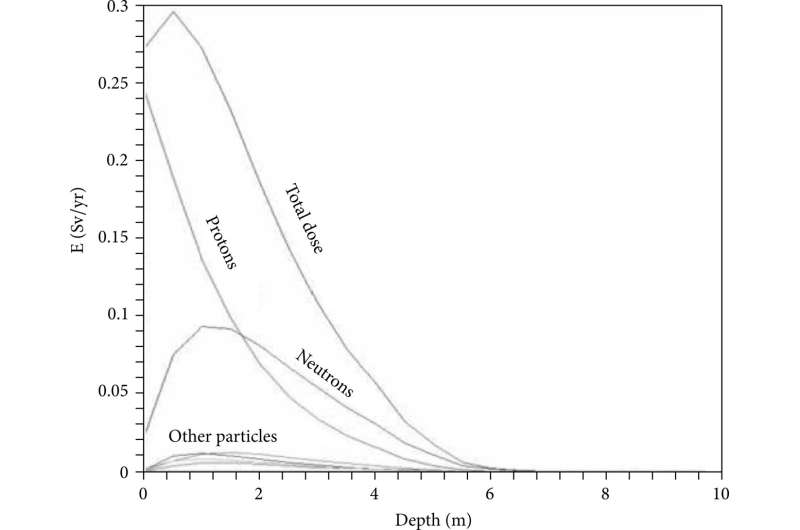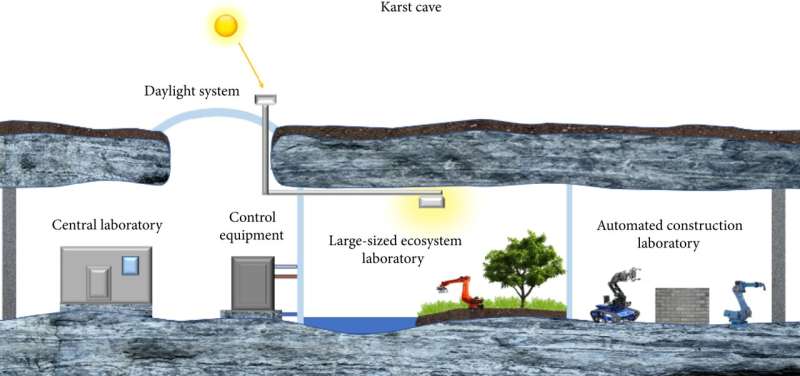They hope to promote the development of related research on extraterrestrial bases through simulation experiments.
The rationality of using a lunar lava tube to establish a lunar base
The external energy required by the closed system involved in the operation of a human lunar base mainly consists of three parts: human respiration, plant photosynthesis, and internal temperature control.
The researchers showed that the minimum energy consumption for maintaining a lunar base hosting 8 astronauts deep inside a lava tube cave is about 145.5 kW in a semicircular tunnel cave with an area of about 8,000 square meters and a height of 50 meters. At this stage, a lava tube is the best choice for establishing a lunar base.
Compared with the lunar surface, lunar lava tubes have the advantages of small radiation and less extreme conditions, more suitable for a human lunar base.
There is a variation in depth of radiation intensity of different particles in the lunar soil. This intensity at 6 m below the lunar surface is almost zero. Even at a depth of less than 1 m, solar flares and solar particle events (SPE) do not affect the interior of the lava tube.
A suitable tube should not be broken down by meteorites. This means that the possible influence radius of the meteorite must be smaller than the tube's burial depth. According to experimental and simulation studies, the safest condition the scientist have now calculated is the ratio of target thickness-to-crater diameter. That is, if it is smaller than 0.87 then a "skylight" (crater) will appear.
There is very little moon dust inside lunar lava tubes. Moon dust is the charged dust formed by small debris on the lunar surface under the action of the solar wind. Being charged, they can be adsorbed on equipment. In addition, moon dust is abrasive, and very harmful to people and machines. But the interior of lava tubes is a permanent shadow zone, generally inaccessible to the solar wind, where charged moon dust is hardly produced.
The moonquakes observed by the lunar seismic network between 1969 to 1977 varied in where, how often and how severely they shook the moon. The fact that the lunar lava tubes has survived on the moon for so many years suggests that its structure is stable enough to withstand the effects of moonquakes. This is a natural advantage over bases built on the moon's surface.

Using a karst cave to simulate lunar lava tubes
Karst caves refer to the underground space formed by the dissolution, invasion, and collapse of soluble limestone under certain conditions. Taking karst caves in Chongqing as an example, the researchers show that Earth karst caves can be considered as good analogs of lunar lava tubes under three aspects: structure, environment, and insulation.
- Structural aspects: Karst caves and lava tubes have different formation mechanisms and environments, but they are comparable in size. They are both curved semicircular caves. The space it provides can meet the research needs at this stage.
- Environmental aspects: Karst caves and lava tubes have relatively mild environments. The temperature range in the cave is between 18 and 25°C. The mild temperature inside the lava tube can reduce energy consumption in terms of heat control. In terms of acidity and alkalinity, the lunar lava tube is mainly composed of lunar basalt. The rock composition is mainly composed of iron and titanium compounds. The hydrolysis product is weakly alkaline. The karst cave is mainly composed of carbonate rock, and most of the hydrolysis product is hydrogen carbonate, also weakly alkaline. In terms of air quality, one advantage of the lunar lava tube is that there is almost no moon dust. For karst caves, they is enough ventilation, oxygen and carbon dioxide contents are within the normal range, and no toxic and harmful gases are detected.
- Insulation aspects: Karst caves and the lava tubes can provide an environment relatively isolated from the outside world. The lunar lava pipeline is protected by the weathered layer, and the internal and external environments are isolated. Due to the lack of conductive media, the internal environment is very independent. As for karst caves, since they have almost no communication with the external environment during their formation process, they are rarely affected by the external environment.
The researchers intend to use karst caves to simulate the internal environment of extraterrestrial caves and isolate them from the external environment by sealing the caves. The cave experiment is divided into two parts. The first part involves automatic construction technology in the cave and in situ utilization technology.
The other part is the artificial ecosystem experiment. Regarding energy supply and light, they plan to use light pipes to introduce sunlight into the ecological laboratory and provide it for crop growth and develop a set of automatic control energy control systems.
More information: Jinghang Ding et al, Karst Cave as Terrestrial Simulation Platform to Test and Design Human Base in Lunar Lava Tube, Space: Science & Technology (2022). DOI: 10.34133/2022/9875780
Provided by Beijing Institute of Technology Press



